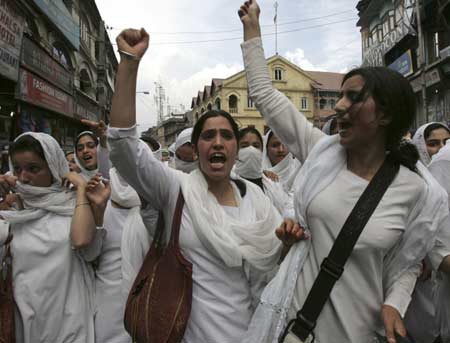By Nusrat Ara
WeNews correspondent
Monday, May 21, 2012
The quality and export of Kashmiri rugs have declined, but one young woman is putting pride and decent wages back into the traditional craft. In a region where such female entrepreneurship is a rarity, she says training makes all the difference.
 SRINAGAR, Kashmir, India(WOMENSENEWS) — Arifa Jan began making namdas, rugs created from felted wool, when she knew that the traditional craft was at a low point.
SRINAGAR, Kashmir, India(WOMENSENEWS) — Arifa Jan began making namdas, rugs created from felted wool, when she knew that the traditional craft was at a low point.
Just 10 years earlier, 98 percent of the namdas that were produced in Kashmir were exported, Jan says. But since then, this had fallen to 2 percent.
“This was a huge decline,” she says.
Jan became interested in namdas during a research project on declining crafts while getting her master’s degree at the Craft Development Institute in Srinagar, Kashmir’s summer capital.
She learned that conflict for two decades in Kashmir had steadily damaged business and hurt the product’s quality. An artisan working with the traditional wool would earn the equivalent of $1 to $2 a day. That couldn’t support a family, so the artisans began using cheaper materials.
“The artisans were then mixing cotton with local wool,” she says. “The quality suffered, and this made the namdas less durable. They also used local dyes, which made the color bleed when exposed to water.”
Exports began to plummet.
As part of her research, Jan was required to introduce innovations to increase the marketability of Kashmiri namdas. So instead of using local wool, she used 100-percent merino, a type of sheep prized for its wool quality. She also used dyes free of azo compounds, a chemical used in dyes for its vivid colors, so they wouldn’t be harmful or bleed.
“You can hand wash our namdas,” she says. “They won’t lose their color. You can even vacuum them, things you can’t do with the ordinary namda you find in the market these days.”
For embroidery, she opted for a superior thread and a style called crewel, often used on curtains.
Reviving Patterns
She also revived patterned namdas, in which patterns are cut from felt of different colors and then combined in a felt base. She experimented with these patterns and with various types of embroidery on these namdas.
Jan prepared 300 namdas as part of the project. In 2010, she took some of her work to a handicraft exhibition in New Delhi.
“It was a sellout,” she says. “I had taken 60 namdas with me, and I sold them all. And the response was so good.”
After the exhibition, Mohammad Saleem Sofi, a pashmina artisan and trader, was impressed. He decided to lend Jan the equivalent of $970 to start production. Gulshan Nanda, chair of the Crafts Council of India at the time, also became a backer. She offered to lend Jan $2,800 to start production.
With this funding, Jan recruited workers and doubled their wages.
“I have seen how hard they work and how little they are paid,” Jan says. “They should get paid well. Only then will the crafts survive.”
Since childhood, Jan had dreamed of venturing into business. Born to illiterate parents, she obtained her bachelor’s degree in commerce at the University of Kashmir with the goal of starting a business in the future.
“I studied commerce, thinking I will start a business of my own one day,” she says. “But at that time, I had no idea that I will work with namdas.”
Jan’s form of success is unusual in Kashmir, where nearly 70 percent of young females surveyed reported that gender discrimination deterred them from pursuing entrepreneurship, according to a 2011 survey conducted by the Start-up Kashmir Youth Entrepreneur Development Project, an anti-poverty group.
Promoting Entrepreneurship
The Jammu and Kashmir State Women’s Development Corporation implements various governmental schemes to identify and promote female entrepreneurs.
“We have got tremendous response from women regarding entrepreneurship,” says Nahida Soz, the corporation’s managing director.
Since the organization focuses on disadvantaged groups, employment is always a challenge.
“It is challenging to make these women self-reliant as they belong to a low socio-economic background,” she says. “The women are not qualified or skilled. But the women of Kashmir are well-versed in various handicrafts, and there is a lot of potential.”
The organization trains women and gives them credit to start their projects. It also helps the women market their products by organizing fairs to ensure income generation.
Jan says her own training has given wings to her dreams. Even though her main focus is on namdas, she is already on the path of diversification.
Together with Sofi and another artisan, Farooq Ahmad Ganai, Jan has started Incredible Kashmir Crafts, a venture that makes namdas and other items, such as embroidered canvas bags, tops, pashmina stoles and shawls, cushion covers and wall hangings. Their focus is on design and innovation, as well as the preservation of Kashmiri handicrafts.
“We have been experimenting with various weaves and designs in pashmina,” Sofi says. “The pashmina we are using is all handspun, and everything we deal in is handmade.”
He says this is unique, as machines have doomed local handicrafts.
And Jan’s not stopping at diversification of quality goods and fair wages for artisans. She also wants to start an organization for women working with handicrafts, especially women in difficult situations as a result of the region’s conflict.


















 Rafiq Maqbool/Associated Press PhotoShaheen, wounded in an earthquake, waits for medical help at Jabla village, 69 miles north of
Rafiq Maqbool/Associated Press PhotoShaheen, wounded in an earthquake, waits for medical help at Jabla village, 69 miles north of 



